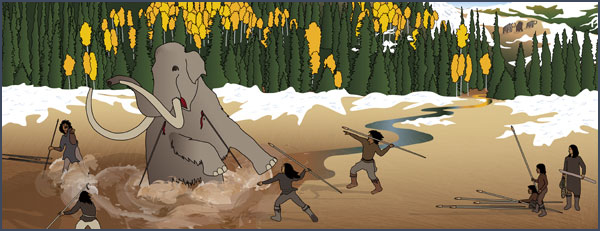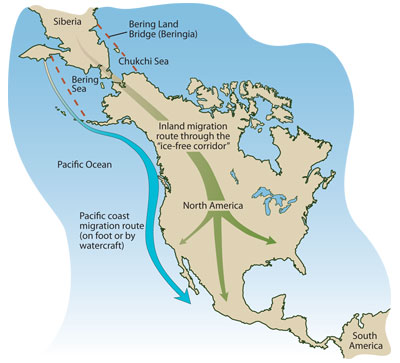Peoples of the Mesa Verde Region
The Paleoindian Period: 13,000 (or earlier) to 6000 B.C.Overview
Imagine a world of snow and ice, when glaciers covered large parts of North America and huge animals, now extinct, roamed the land. The time is the late Ice Age—also known as the Pleistocene—and humans have entered the North American continent for the first time. 
Paleoindian hunters stalk and kill a mammoth during the late Ice Age. Archaeologists call this earliest occupation of the Americas the Paleoindian period. Paleo means "ancient," and the Paleoindian period refers to the time when small bands of nomadic hunters first entered North America and subsequently spread out across the landscape. Similarities among stone artifacts found from Canada to Mexico suggest that people moved relatively quickly to all corners of the continent and shared a cultural tradition across vast distances. 
Possible migration routes from Siberia to North America. Exactly when and how humans first came to North America is a hotly debated topic. Many archaeologists believe that people traveled from east Asia, through Siberia, to the Bering land bridge, also called Beringia. There it appears they lived in isolation for several thousand years, before crossing into Alaska and beginning their migration throughout North and South America. How did people make the journey south? They may have simply walked along the Pacific coast, following an ancient shoreline that was exposed during the late Ice Age, when water levels were lower than they are today. It is also possible that people traveled by watercraft, staying close to shore and making camp along the way. Whether people traveled the coast by land or sea, it is likely that many of the earliest archaeological sites are now underwater, having been submerged as the glaciers melted and sea levels rose at the end of the Pleistocene. Alternatively, or in addition, some people may have traveled south through what is called the "ice-free corridor," an inland passage through the center of North America that was not covered by the late Ice Age glaciers. Few Paleoindian sites have been discovered in the Mesa Verde region, and those that are known are identified primarily on the basis of isolated projectile points. The relatively small number of known Paleoindian sites is due to the great antiquity of the sites, the nomadic lifestyle of the people, and the low population during this time. . . . about how the Bering Land Bridge formed and when it disappeared. What about recent theories proposing that the first people to inhabit the Americas came from Europe? |
|
 DONATE TODAY
DONATE TODAY
